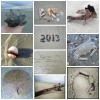Ahead of Time:
Using note cards, write RNA codons, at least one for each amino acid. 1 codon per card. I also included the anticodon at the bottom of the card so the "rRNA" could line it up on the mRNA strand to show the order it would go in. Make sure you have already created your "original" DNA code on receipt paper or paper towel strip. You can simply make only the RNA and amino acid codon cards that will transcribe from the DNA code you have created instead of every one on the chart. Create more than one strand of DNA and sets of codon cards to do this multiple times.
Explain to students that they are going to "act out" transcription and translation in a cell. The entire classroom defines the cell. They use desks, lab tables, chairs, etc. as props. We put desks in a circle and left spaces between some of them for the nuclear membrane.
Tell them they are going to need to create the nucleus for the DNA (a student) which will hold the message you have created ahead of time. I was resourceful and used a strip of paper towel from brown paper towels I had in my classroom. I used marker to write about a six or seven codon long chain of DNA. Make sure you begin with the correct code that will transcribe and translate into the "start" codon and end with a code for a "stop" codon.
The students need to collaborate and assign people to be mRNA, rRNA, tRNA, DNA, and the rest are amino acids.
The two organelles in the "cell" are the nucleus and a ribosome. The amino acids can spread out in the "cytoplasm" of the cell (room).
Use the name tags or labels to write mRNA, rRNA, tRNA, DNA, and each person's amino acid name on to wear on their shirt. I hand out the codon note cards I have made and have the students use the chart to translate their RNA codon to the correct amino acid and write it on their name tag. They use the note card to "report" to the rRNA and know where to line up.
The DNA will be given the original strip of DNA you made ahead of time. mRNA will be given a blank strip and a marker so they can go into the nucleus, transcribe, and then take the message to the rRNA at the ribosome. The rRNA will then read the message and instruct tRNA as to which amino acid they need to build the protein. As tRNA brings the amino acid to the ribosome the rRNA lines them up in order. I had mine hold hands to simulate the chain being created and then shift out away from the ribosome.
We did this a couple of times with different strands of DNA I had created ahead of time so that different amino acids could be used and in different orders. As the teacher I observe and give direction when/if needed.

